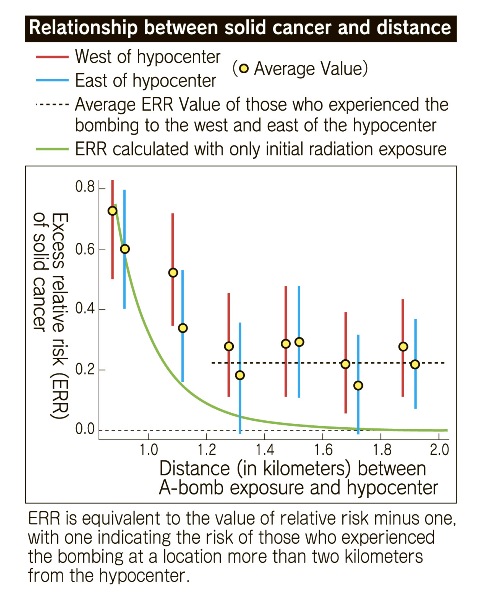Research on cancer risk in A-bomb survivors finds greater impact of indirect exposure to A-bomb radiation
Nov. 5, 2012
by Tomomitsu Miyazaki, Senior Staff Writer
Research conducted by Hiroshima University’s Research Institute of Radiation Biology and Medicine (RIRBM), located in Minami Ward, Hiroshima, has revealed that the initial level of radiation exposure suffered by those at locations between roughly 1.2 kilometers and 2 kilometers from the A-bomb hypocenter accounts for only up to one-third of the mortality rate of solid cancers. The institute’s analysis suggests that indirect exposure to the bomb’s radiation, including residual radiation and radioactive fallout, has been a greater influence on the rate of mortality than the radiation exposure suffered at the time of the explosion.
The team of researchers, comprised of Megu Ohtaki, a professor at RIRBM, and others, observed a total of 27,643 A-bomb survivors who were directly exposed to the atomic bombing and still living as of January 1, 1970, following them to the end of 2009. They made calculations on the mortality rate for survivors with respect to solid cancers, excluding leukemia, in line with the distance of their location from the hypocenter when the atomic bomb exploded.
Based on this data, the researchers compared the mortality rate for A-bomb survivors, after taking into account such factors as shielding conditions due to buildings or other elements as well as deviations attributable to age or gender. Employing the maximum estimate for the risk wrought by the initial burst of radiation from the bomb, the researchers determined that this initial radiation exposure raised the mortality rate by one-third at most.
Currently, a survivor’s risk is calculated by estimating the initial dose of radiation that they were likely exposed to, based on that person’s distance from the hypocenter when the blast occurred. Given the same shielding conditions, this means that the farther a survivor’s distance from the hypocenter when exposed, the lower the risk.
The new research, however, suggests that there is virtually no difference in risk between those exposed to radiation at approximately 1.2 kilometers from the hypocenter and those exposed at 2 kilometers.
It was found, however, that the risk for people who were exposed to the atomic bombing west of the hypocenter is slightly higher than exposure from the east. Professor Ohtaki believes that survivors located west of the hypocenter suffered greater exposure to dust containing nuclear substances as well as the radioactive “black rain” that fell in the aftermath of the blast.
(Originally published on October 29, 2012)
Research conducted by Hiroshima University’s Research Institute of Radiation Biology and Medicine (RIRBM), located in Minami Ward, Hiroshima, has revealed that the initial level of radiation exposure suffered by those at locations between roughly 1.2 kilometers and 2 kilometers from the A-bomb hypocenter accounts for only up to one-third of the mortality rate of solid cancers. The institute’s analysis suggests that indirect exposure to the bomb’s radiation, including residual radiation and radioactive fallout, has been a greater influence on the rate of mortality than the radiation exposure suffered at the time of the explosion.
The team of researchers, comprised of Megu Ohtaki, a professor at RIRBM, and others, observed a total of 27,643 A-bomb survivors who were directly exposed to the atomic bombing and still living as of January 1, 1970, following them to the end of 2009. They made calculations on the mortality rate for survivors with respect to solid cancers, excluding leukemia, in line with the distance of their location from the hypocenter when the atomic bomb exploded.
Based on this data, the researchers compared the mortality rate for A-bomb survivors, after taking into account such factors as shielding conditions due to buildings or other elements as well as deviations attributable to age or gender. Employing the maximum estimate for the risk wrought by the initial burst of radiation from the bomb, the researchers determined that this initial radiation exposure raised the mortality rate by one-third at most.
Currently, a survivor’s risk is calculated by estimating the initial dose of radiation that they were likely exposed to, based on that person’s distance from the hypocenter when the blast occurred. Given the same shielding conditions, this means that the farther a survivor’s distance from the hypocenter when exposed, the lower the risk.
The new research, however, suggests that there is virtually no difference in risk between those exposed to radiation at approximately 1.2 kilometers from the hypocenter and those exposed at 2 kilometers.
It was found, however, that the risk for people who were exposed to the atomic bombing west of the hypocenter is slightly higher than exposure from the east. Professor Ohtaki believes that survivors located west of the hypocenter suffered greater exposure to dust containing nuclear substances as well as the radioactive “black rain” that fell in the aftermath of the blast.
(Originally published on October 29, 2012)








